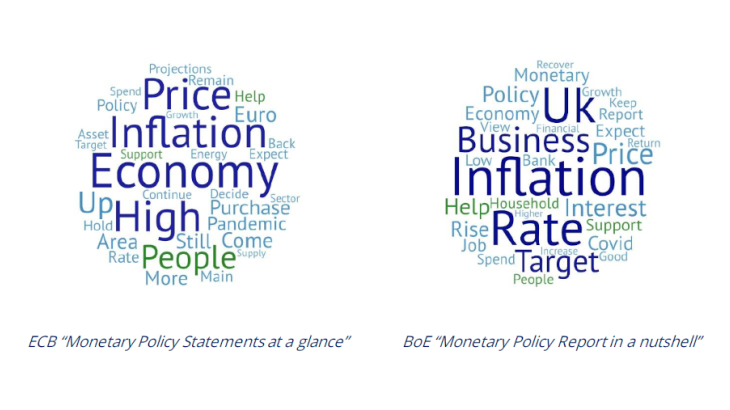Note: The chart shows a word cloud of the 30 most frequent words based on the ECB’s “Monetary Policy Statement at a glance” from July 2021 to September 2022 and the Bank of England (BoE)’s “Monetary Policy Report in a nutshell” from November 2019 to August 2022. The bigger and bolder the words, the more frequent they are in the text.
Moving towards greater clarity
With the objective of making policy decisions understandable to a wider public, some central banks have started to supplement the publication of their policy statements by streamlined summaries that use simpler language and infographics (a “multi-layered communication”). The layered communication tailored to different users is a practice initiated by the BoE, which started in 2017. Currently more central banks have adopted this practice, which combines text and visuals to cater to different audiences. The idea is to explain monetary policy in simpler terms, so that people can understand why decisions are taken and what this means for their lives (see also BdF blog 244).
In this blog, we discuss some characteristics of the layered communication, in terms of level of complexity and topic coverage, with regard to the Monetary Policy Statements of the ECB, the Fed and the BoE.
Monetary policy decision in plain-speak
Since its Strategy Review of July 2021, the ECB supplements its Monetary Policy Statement (MPS) by a layered, visual version (“Monetary policy statements at a glance”), geared toward the wider public. This is in line with a move towards a more layered communication by central banks, with differences in the level of layering across banks. Since August 2015, the BoE for instance has published its monetary policy decisions through a Monetary Policy Summary (MPS) at each policy meeting. Since November 2017, each quarter, the policy decision has also been supplemented by a Monetary Policy Report (MPR), published in three layers. The first ‘layer’ explains the interest rate decision in an abbreviated format alongside icons. The second ‘layer’, called “In a nutshell” is a visual summary of the MPR consisting of a more in-depth, but still brief, overview of the main factors behind the interest rate decision. The third layer consists of the full MPR written in more technical language.
Chart 1 shows the top 30 words in the ECB’s “MPS at a glance” and BoE’s “MPR in a nutshell”. Beyond the standard top words like “inflation”, “economy”, “interest rates”’ we also observe words like “people”, “businesses”, “help”, “support”, “spend” and “jobs”. The latter are simpler compared to the top words in the respective MPS, which tend to be more technical. They are also predominantly specific to the ‘’nutshell” communication showing that, under this layer, the monetary policy decision is explained in terms of how it helps and supports people, businesses and jobs.
Indeed, Chart 2 illustrates that the traditional policy statements of the ECB, the BoE and the Fed have a high level of complexity when measured through readability metrics, such as the Flesch-Kincaid Grade, which is generally used to approximate the number of years of education necessary to understand a text. On average, we observe that the MPSs hover around a score of 15, meaning that 15 years of education (20-21 years old) are necessary to understand it. This is in contrast with the respective “at a glance” or “’nutshell” versions of the ECB and BoE, which attain a score of below 8, or eight years of education corresponding to a reader of a school age, i.e. 13 to 14 years old.
Note that while the Fed does not have a formalised layered communication of its policy decisions, its MPS readability score has significantly improved following its Strategy Review in August 2020, as shown in Chart 2. Similarly, following its Strategy Review in July 2021, the ECB has also redesigned its Monetary Policy Statement to explain in less technical terms how and why decisions are taken.


